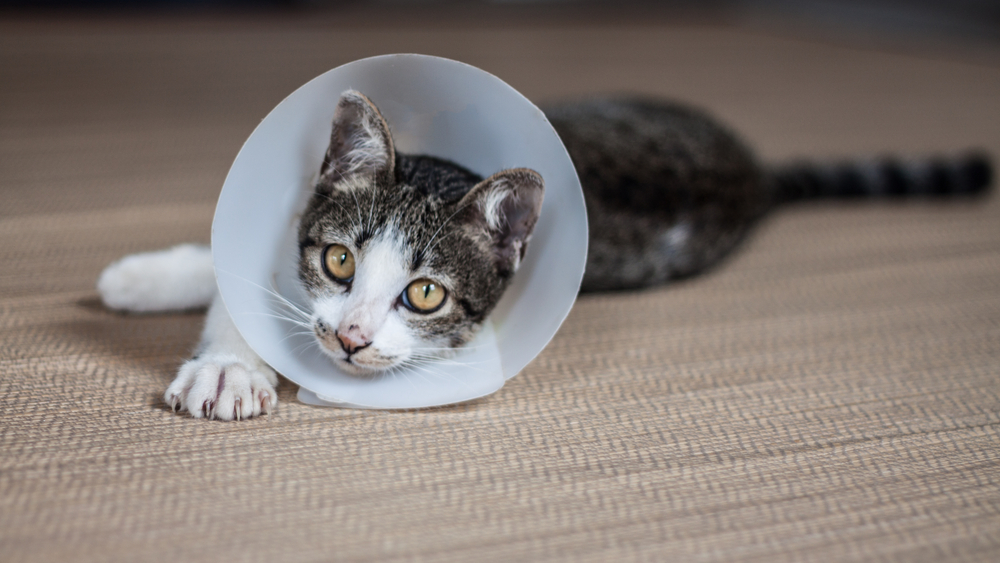
You love your pet, and do everything to ensure they live a long and healthy life. At Towne Centre Animal Hospital, our mission is the same, which is why we approach your pet’s veterinary care with the goal of preventing avoidable health issues before they begin. One way we ensure your pet stays healthy is by spaying or neutering them at an early age. We understand, as with any veterinary surgery, you may have questions or concerns about your pet’s health and safety so, to help you make an informed and confident decision, we provide this basic guide to spaying and neutering.
The pet spay and neuter explained
Spay and neuter sterilization procedures eliminate your pet’s ability to reproduce, not only helping reduce pet overpopulation, but also significantly—and sometimes completely—eliminating your pet’s reproductive-related disease risk, including some cancers. Here is each procedure’s detailed breakdown:
- The spay — During the spay procedure (i.e., ovariohysterectomy), the veterinarian creates an abdominal incision, and removes female dogs’ and cat’s ovaries and uterus. Alternatively, some veterinary professionals perform an ovary-sparing spay (i.e., hysterectomy), removing only the uterus.
- The neuter — During the neuter procedure (i.e., castration or orchiectomy), the veterinarian excises male dogs’ and cats’ testicles through a skin incision in front of or over the scrotum. For large-breed adult dogs, the veterinarian may remove the scrotal sac (i.e., scrotal ablation). If a dog retains either testicle in their abdominal cavity, the veterinarian must perform a more involved procedure.
Pets’ spay and neuter benefits
Spaying and neutering have long been the most effective methods for preventing unwanted litters, and thereby controlling pet overpopulation. Contrary to popular belief, pets are not emotionally attached to their reproductive status, and will not experience remorse if they cannot have a litter or maintain their “manhood.” In fact, surgically sterilized dogs and cats live longer, healthier, and more emotionally stable lives. Additional benefits include:
- Improved health — Spayed females do not suffer reproductive emergencies, such as pyometra (i.e., infected uterus) or false pregnancies.
- Eliminates heat cycles — Spayed females do not experience behavior-changing heat cycles or unwanted litters.
- Reduced cancer risk — Female pets spayed at an early age have virtually no mammary cancer risk. Neutered male pets’ testicular cancer risk is eliminated and their prostate cancer risk is lowered.
- Fewer hormone-related behavior problems — Spaying or neutering your pet before hormone-related behaviors (e.g., roaming, urine marking, aggression) arise can prevent them altogether. If the behavior is already present, surgical alteration may reduce the behavior’s intensity or frequency.
Anesthesia safety for your pet’s spay or neuter
Many pet owners express concern about their pet being anesthetized for their spay or neuter surgery. Although anesthesia administration is not risk-free, our Towne Centre Animal Hospital team follows the safest anesthetic protocols. We adhere to strict guidelines to ensure your pet’s comfort and safety including:
- Presurgical exam and diagnostic testing
- Electronic and hands-on monitoring
- Intravenous catheter
- Customized anesthetic protocols
- Postoperative care and observation
Scheduling your female pet’s spay
For maximum health benefit, your female pet’s spay surgery should be performed before their first heat cycle—between 4 and 5 months of age for kittens and before 6 months of age for small- to medium-breed puppies (i.e., expected adult weight of 45 pounds or less). Spaying at this age virtually eliminates mammary cancer risks and prevents the heat cycle’s unnecessary mess and inconvenience. If you have adopted a female and a male kitten, early spaying is essential, as cats reach sexual maturity at an early age. Fortunately, young female pets recover quickly from the spay procedure, returning to their normal routine in about 10 to 14 days.
If your female pet has already experienced their first heat cycle, they can still be spayed safely. However, you and your veterinarian must decide the appropriate timing—spaying immediately after or during a heat cycle increases the chances of complications and is best avoided.
Scheduling your male pet’s neuter
Determining when to neuter a small to medium-sized male pet is more straightforward. AAHA guidelines recommend neutering male kittens between 4 and 5 months of age, and small- to medium-breed male puppies at 6 months of age. Be aware that shelter pets may be neutered as early as 8 to 10 weeks of age, although homed kittens and puppies are usually given time to grow and develop.
Large-breed dogs’ orthopedic-related considerations

With large- and giant-breed dogs, the best spay or neuter age is more difficult to determine. Hormones play an important role in these pets’ physical development, including the closure of long-bone growth plates. When sterilized at an early age, these large dogs will more likely develop orthopedic conditions (e.g., cranial cruciate ligament rupture, hip dysplasia, other joint-related issues). You should carefully consider the timing of your large-breed dog’s spay or neuter, so discuss the procedure with our Towne Centre Animal Hospital veterinarian.
Deciding to spay or neuter your pet is one of the most important decisions you can make for their health and longevity, and one that also positively affects the entire community by controlling animal overpopulation. If you have questions about your pet’s spay or neuter, contact our Towne Centre Animal Hospital team so we can discuss your pet’s health, behavior, projected growth, and lifestyle, to determine the best time for this important health milestone.
